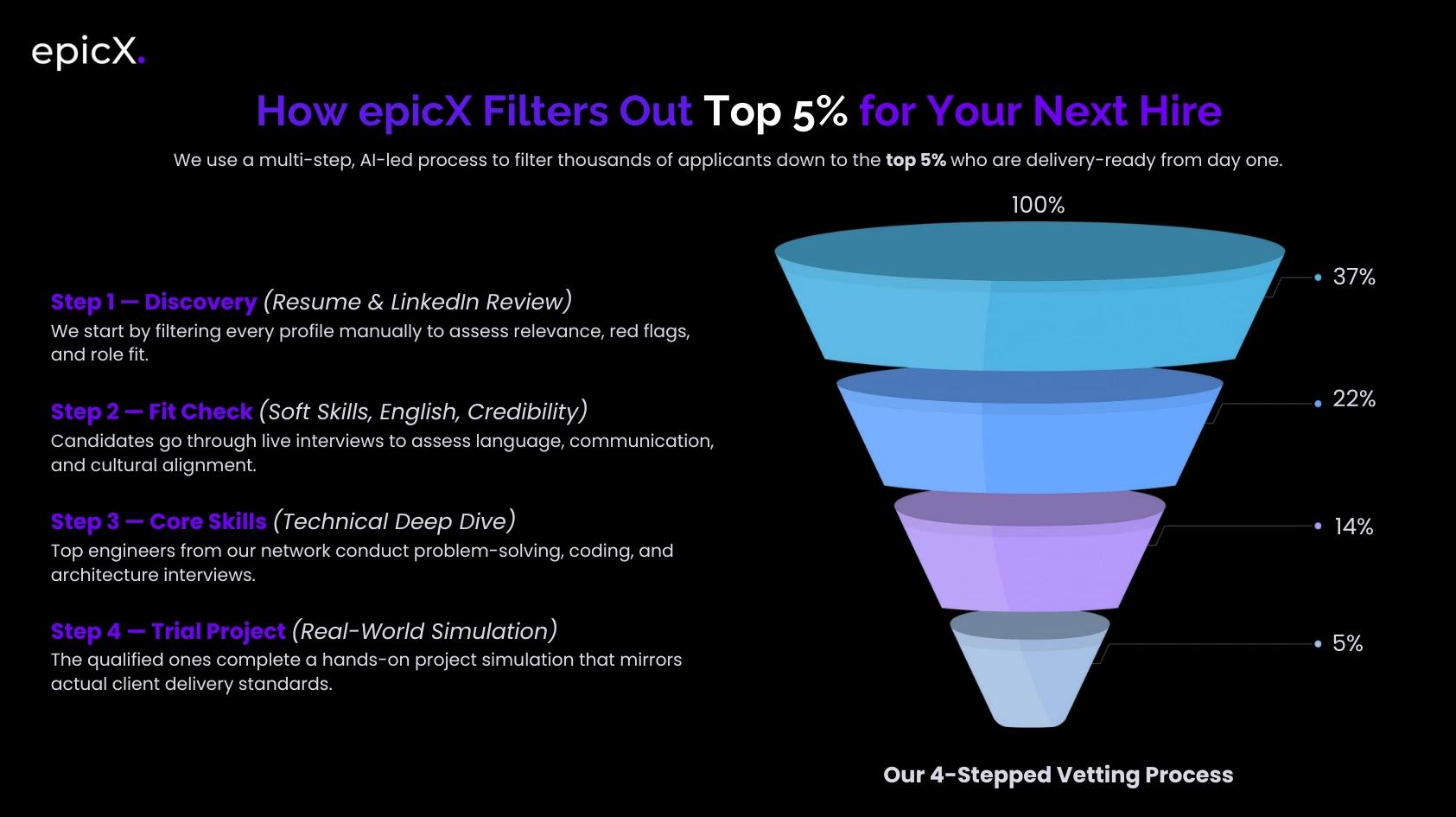“I spent three weeks explaining what we needed, got a polished sprint plan… and then the devs shipped something that solved the wrong problem.”
That’s how one founder described their experience working with a top-rated dev agency.
And they’re not alone.
Tech outsourcing has long been pitched as a silver bullet for startups, giving you access to “world-class talent” at “fractional cost” while freeing you up to focus on what really matters: product, users, and growth.
But behind the polished decks and buzzwords lies a mess of bloated processes, disjointed teams, and an operating model still stuck in the enterprise era. It’s not that outsourcing is inherently broken. It’s that it was never built for the way startups operate.
Startups live in chaos and thrive on clarity, speed, and aligned execution. But the typical outsourcing model? It slows them down more often than it speeds them up.
Let’s unpack why.
The Problem Beneath the Surface
Traditional tech outsourcing doesn’t fail because of bad developers. It fails because of bad structure, the systems and incentives that govern how those developers are sourced, engaged, and managed.
1. Middlemen Dilution
Founders often expect a lean team and quick feedback loops. What they get instead are layers: account managers, project leads, business analysts, and sometimes even translation buffers.
Each layer adds latency and interpretation error. Founders don’t just lose time, they lose clarity and ownership.
Product decisions are slowed down, technical details get diluted, and feedback cycles stretch from minutes to days. It’s outsourcing with earmuffs on.
2. Vetting That Doesn’t Go Deep Enough
“Pre-vetted,” “top 1%,” “Silicon Valley caliber” almost every vendor says the same thing. But what does it really mean?
Most vetting processes focus on skills, not context. Can they write clean code? Sure.
But have they ever owned features? Worked in scrappy teams? Pushed under pressure? Balanced shipping fast, while making smart tech debt calls?
That’s the nuance missing in most outsourced setups. As a result, founders are matched with talent that ticks the box but misses the mark.
3. Asynchronous Time Zones, Asynchronous Momentum
The common defense of working across time zones is, “Your product builds while you sleep.” But startup building is rarely that linear.
Every hour counts when you’re validating, iterating, and firefighting. Delays of 12–24 hours for a small clarification or bug fix can stall an entire sprint. Multiply that by weeks, and you’ve got friction baked into your velocity.
4. Nobody Owns Outcomes
In traditional outsourcing, success is measured by deliverables, not impact. A feature is “done” because it was shipped. A sprint is “done” because the Jira board says so.
But was it the right feature? Does it work? Is it usable? Scalable?
When teams are optimized for activity over outcome, the product suffers. You can’t outsource ownership, and most models never try to.

The Human Cost of Broken Outsourcing
What’s often missed in all this talk about processes and pricing is the emotional toll it takes on startup teams.
One founder we spoke to described spending nights rewriting Jira tickets, trying to get the dev team to understand why a feature wasn’t just “wrong”, it was irrelevant.
Their CTO had become a full-time translator. Their in-house team started skipping standups because they no longer believed anything would change.
Founders become reluctant project managers. CTOs get buried in communication overhead. In-house teams lose momentum or trust in their external collaborators. Developers burn out or disengage due to a lack of vision and agency.
What was supposed to unlock speed becomes a drag on progress. What was meant to reduce cognitive load creates constant anxiety.
Outsourcing — intended to unlock focus — ends up becoming a focus drain.
For startups already stretched thin, this isn’t just annoying. It’s existential. Because every week lost to misalignment is a week of customer churn, missed investor interest, or product regression.
The cost is real, and it’s personal.
The Structural Flaws Behind the Chaos
Why does this keep happening? Because the traditional outsourcing model was designed for a different world.
It Rewards Process, Not Progress
Agencies bill by the hour. They thrive on complexity. The more people involved, the more meetings scheduled, the longer the scope, the more money they make.
There’s no real incentive to move fast or solve the core problem. The reward system is tied to motion, not momentum.
It Was Built for Enterprises, Not Startups
Outsourcing was born in the world of Fortune 500s. It assumes defined roadmaps, stable budgets, and long planning cycles.
Startups don’t have that luxury. They build while pivoting. They test live.
They fire bullets before cannonballs. They need flexibility and contextual alignment, not waterfall handoffs and gated workflows.
Trying to plug an enterprise tool into a startup socket? That’s how you blow a fuse.
It Hides the Builders Behind the Curtain
Too many outsourcing shops hide their technical teams behind client service layers. Founders don’t know who’s writing their code.
Engineers don’t understand the product context. Everyone works in silos, without shared goals or vision.
It’s Optimized for Repeatable Tasks, Not Ambiguous Building
Outsourcing thrives when requirements are fixed and repeatable.
But startups often live in ambiguity, validating, experimenting, and adapting in real time. That demands intuition and agency, not just instruction-following.
Enter epicX: Flipping the Model from the Inside
epicX didn’t start as a services company. It started as a response to this broken model.
Built by startup operators who’ve felt these pains firsthand, epicX reimagines technical execution, not as a vendor-client engagement, but as a startup-native partnership.
epicX isn’t a dev shop. It’s not a marketplace. And it’s definitely not a staffing firm.
It’s a velocity partner, one built to plug directly into early-stage chaos and make momentum happen.
The goal isn’t to sell hours. It’s to help founders move faster, ship better, and stay focused.
Instead of throwing bodies at tickets, EpicX steps in with founder empathy, startup-seasoned engineers, and a delivery model designed for speed, clarity, and trust.
Whether it’s a GenAI prototype, a mobile rebuild, or backend scale under fundraising pressure, EpicX isn’t just a vendor that delivers code.
It’s a partner that delivers product progress.
Because at the end of the day, startups don’t need more contractors.
They need co-builders.
Why epicX is a Preferred Tech Outsourcing Partner for Startups
Founder-Led Engagements
Every epicX engagement starts with someone who’s built a product, not someone selling services. This changes the dynamic from day one.
Founders talk strategy, not just specs. Tradeoffs, not just timelines. The result is instant clarity and faster alignment.
No endless sales calls. No scope-to-death proposals. Just a real conversation with someone who gets what it means to ship under pressure.
Context-Rich Talent Matching

epicX doesn’t just drop in developers. It matches startup-ready engineers based on experience, product context, and team culture.
Before recommending anyone, epicX asks:
- Is this person comfortable with ambiguity?
- Have they shipped under pressure in early-stage environments?
- Do they bring product intuition, not just syntax mastery?
Only after these boxes are checked do matches happen.
For example, a venture-backed AI startup was weeks away from investor demos and needed to rebuild its MVP from scratch.
They reached out to epicX on a Friday. By Monday, they were in Slack with an engineer who had previously shipped two GenAI products.
Five weeks later, they were live with a working product, not just a codebase.
Same Time-Zone Execution
No more 24-hour wait times. Every epicX engineer works in your time zone, which means live standups, rapid iteration, and instant feedback.
This enables real-time debugging, shared urgency, and visible momentum.
Direct Collaboration, Zero Middlemen
At epicX, the people writing your code are the ones you talk to. No PM buffers, no Chinese whispers.
Whether it’s Slack, Loom, Figma, or Zoom, you collaborate directly with your team. You move faster, and they stay closer to the product.
Because alignment isn’t just a value. It’s how good software gets built.
Built for Builders: Why epicX Stands Apart
epicX isn’t a one-size-fits-all vendor. It was purpose-built to serve high-velocity founders operating in unpredictable environments.
Need a cross-platform mobile engineer? epicX can match you with someone who’s shipped in similar stacks under real startup constraints.
Racing to rebuild your backend in time for a pilot launch? epicX has engineers who’ve done exactly that and understand how to balance scale with speed.
Want to validate a GenAI product before your next round? epicX teams have shipped multiple LLM prototypes in under 30 days.
And it’s not just about resourcing. It’s about working with people who think like owners and move like founders.
A Better Future for Startup Execution
The future of tech outsourcing isn’t more agencies. Or cheaper freelancers. Or fancier dashboards.
It’s about smarter models. More aligned teams. And builders who operate like extensions of your founding team.
Outsourcing doesn’t have to be broken.
With the right structure, it becomes your unfair advantage.
With epicX, it already is.





